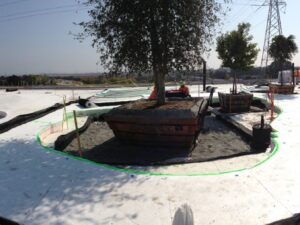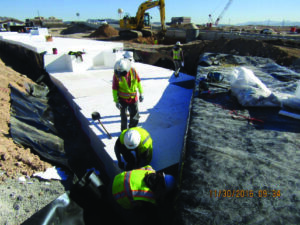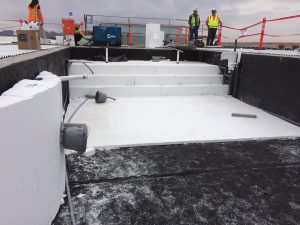Geofoam at Work: Engineered to Address Geotechnical Challenges and Maximize Operating Efficiencies
Building professionals have utilized expanded polystyrene (EPS) geofoam (GF)—an engineered, lightweight fill material—for decades to “design by function, that is, to focus on the key geosynthetic functions they’re looking for in a particular project,” according to the EPS Industry Alliance. Some of those geotechnical challenges include:
- lightening loads on structures, utilities or underlying soils

- remediating soft soils and minimizing differential settlement
- stabilizing steep slopes and embankments
- reducing lateral load behind retaining structures
- serving as a structural void fill for concrete or landscaping applications
Within each of these unique applications, custom-built blocks of EPS geofoam can help accelerate construction timelines and trim the labor and material costs that are typically associated with such projects. Here’s how the high-performance fill solution maximizes operating efficiencies and keeps projects in the black…
Prefabricated EPS geofoam speeds up construction timelines and lessens impact on the jobsite
Potentially hard pressed to make up for lost time after the precariousness of 2020, many building professionals are looking to prefabrication—a method in which components of a project are assembled off-site in a specialized shop—as a means of making up ground on delayed project timelines. Custom-built on the factory floor, EPS geofoam is a prefabricated building tool that “allows contractors to do more with less—what was once a two-person job can now be a one-person job, limiting jobsite density and lessening impact on the surrounding area,” reports Contractor magazine.
EPS geofoam’s multi-functionality supports project cost-savings
 An attractive solution over traditional fill materials such as soil and concrete, EPS geofoam can support significant labor, material and equipment savings. Ultra-lightweight, EPS geofoam is manufactured in various unit weights that range from 0.7 to 2.85 pounds per cubic foot. In fact, EPS geofoam is approximately 100 times lighter than most soil types, and 20 to 30 times lighter than concrete. Because EPS geofoam has such a lightweight composition, large earthmoving equipment is not required during installation. Instead, the rigid foam can be installed easily and efficiently by hand. The custom-built blocks are designed to lock in place, much like stacking blocks or assembling a puzzle—which brought this major Colorado highway repair to completion in an impressive 20 days. What’s more, because EPS geofoam imparts minimal stress to underlying soils, structures and utilities, there is generally no need for specialized foundations or site preloading to reduce settlement and improve bearing capacity—an advantage that saved the Utah Transit Authority $20 million and eight months of added labor.
An attractive solution over traditional fill materials such as soil and concrete, EPS geofoam can support significant labor, material and equipment savings. Ultra-lightweight, EPS geofoam is manufactured in various unit weights that range from 0.7 to 2.85 pounds per cubic foot. In fact, EPS geofoam is approximately 100 times lighter than most soil types, and 20 to 30 times lighter than concrete. Because EPS geofoam has such a lightweight composition, large earthmoving equipment is not required during installation. Instead, the rigid foam can be installed easily and efficiently by hand. The custom-built blocks are designed to lock in place, much like stacking blocks or assembling a puzzle—which brought this major Colorado highway repair to completion in an impressive 20 days. What’s more, because EPS geofoam imparts minimal stress to underlying soils, structures and utilities, there is generally no need for specialized foundations or site preloading to reduce settlement and improve bearing capacity—an advantage that saved the Utah Transit Authority $20 million and eight months of added labor.
Interested in learning more about the advantages of employing EPS geofoam? Contact an Insulfoam representative here.





